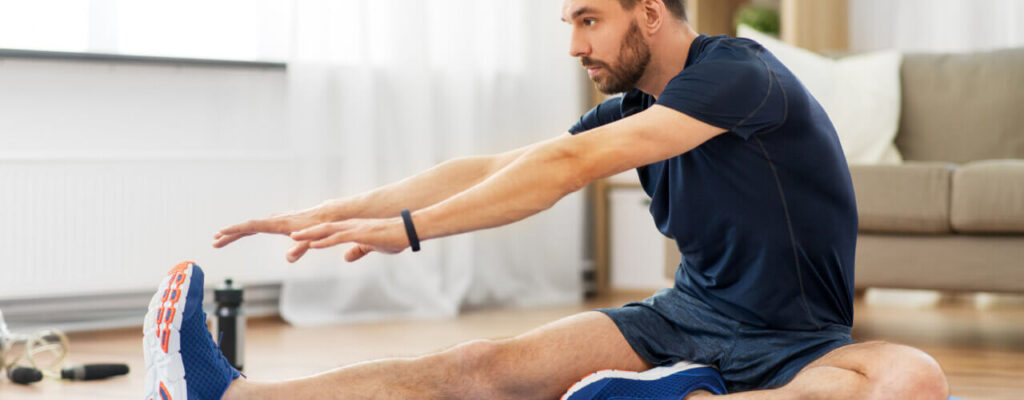Is Stretching Important Before AND After Workouts?

Have you been told that stretching helps decrease the risk of injury?
Do you make time to go to the gym a few times per week? If so, you should commend yourself for your efforts.
But at our clinic, we notice an interesting trend with a lot of our active patients: they go to the gym regularly, but they largely neglect stretching and mobility work, despite believing that stretching should be done in some form before and after workouts.
We’re not sure why this is so common—maybe because stretching doesn’t seem as “exciting” as an actual workout.
So what does the research say?
Stretching and Physiotherapy
Stretching exercises have traditionally been included as part of a training and recovery program, because patients come in often complaining of tightness. But the literature (Stanton et al, 2016) shows that in most people, the perception of tightness protects us from doing more of what it is that we are doing, before it actually provokes pain, or ultimately, leads to an injury. Essentially, tightness can be considered as one of our body’s alarm systems.
So when you describe feeling tight, it’s important for us to understand what you mean. Are you…
- limited in your range of motion?
- uncomfortable at your end range?
- not feeling relaxed?
- having some discomfort (not pain) in an area?
Changing the Perception of Tightness
If that perception of tightness is an alarm telling you to stop a particular movement, why would you push it even more?
The key is not to push it with stretching, but instead we need to change the input of that particular movement or position to the nervous system so that it is no longer perceived as a threat. How do we do that? It’s not an easy answer, and context is definitely key, but here are some suggestions.
- Move – this can be as simple as regularly taking yourself out of prolonged positions, or just changing positions frequently. Or, it can mean moving the joint(s) in the opposite direction.
- Motor control – do you have control of your body at its joint end ranges? If your brain doesn’t think so, then it will let you know by increasing the tightness around that joint. There are many forms of movement, therapy, or therapeutic exercises that help you with motor control at end ranges. It can be as simple as slowly moving in and out of your end ranges; more formal practices like pilates and vinyasa yoga; therapeutic strategies like CARS, PAILS, and RAILS (see the work by the FRC people). But one of our favourites . . .
- Resistance training – plain and simple, strengthening creates adaptations in muscles that make them more resilient to distress. There is a common misconception that it makes your muscles shorter, stiffer, or tighter, but that’s one big myth. In fact, a well planned resistance program may increase your flexibility more than traditional stretching.
Did You Say Strengthening Helps with My Tightness and Flexibility?
I said it! But I’m just passing along the information from people smarter than me.
In a recent systematic review and meta-analysis (Alphonso et al 2021), the effects of strength training (ST) were matched against stretching when it came to improving range of motion (ROM). Upon analyzing the data, here’s what they found:
- ST seems to be just as effective, if not more, as stretching in reducing perceptions of tightness and improving ROM. (This seems to be in contradiction with existing guidelines and public thought)
- There’s a strong argument to prescribe ST over stretching, as it can not only improve ROM, but it can also provide a host of other benefits that stretching cannot, such as: improved muscle mass, increased bone density, decreased injury, and decreased falls risk.
So there you have it. Contrary to what you’ve been told, you actually don’t have to stretch to reduce your tightness and improve your range of motion!
Wait a Sec! Did You Just Sneak in that Strengthening Reduces Injury More than Stretching?
You bet!
Lauersen et al. (2014) looked at various exercise programs to determine their effectiveness of reducing/preventing sports injuries.
Here’s what they found.
- Strength training showed a highly significant protective effect against sports injuries; in fact, it reduced sports injuries to less than 1/3! (It reduced injuries by 69%).
- Proprioception training and multiple exposure training (i.e., combo of different exercise types) also had a protective effect, but neither as large of an effect as strength training. (It reduced injuries by 45%).
- Stretching showed NO protective effect against sports injuries. (OK, it reduced some injuries. But only by 4%).
So you really can’t go wrong trying to get strong.
Great! But My Original Question Asked What I Should Do Pre- and Post-Workout.
Oh that’s right, and I went off on a tangent (albeit an important one). Warming up and cooling down remain important.
For warming up, consider breaking up your activity into component movements and do those components dynamically and under control, especially at the end ranges. Eventually, combine those components and build up the resistance or the speed until you are performing that exercise or activity itself. For example, when performing a leg day at the gym – you may work on individual ankle, knee, hip, back, and shoulder mobility following a quick warm up; and then right into your first exercise (ex. squat or deadlift) starting with light resistance sets and eventually progressing to your main ones (ex. 4 x 5 at X amt wt, RPE 9, rest 3min).
For recovery, the goal would be to bring your heart rate down and go through the same component movements under control, almost like a system check to to assess that everything after your session feels the same as it did prior to your session. If you do like to perform prolonged stretching exercises, now is a good time.
I’ll finish by saying that being flexible and stretching is not bad. In fact, some athletes need great ranges in motion to perform – think about a hockey goalie making a split save, or a figure skater performing a Bielman.
So here’s where stretching can benefit you:
- You need to be flexible to perform your vocation.
- You find stretching relieves physical and mental stress.
- You use stretching to socialize (ex. meeting some friends at a yoga class).
- You think stretching is, otherwise, enjoyable.
Want more help? We’ve got you covered!
Our physiotherapy and chiropractic practitioners are happy to help you problem-solve and figure out the best routine for your body. So schedule an appointment with one of them today.

